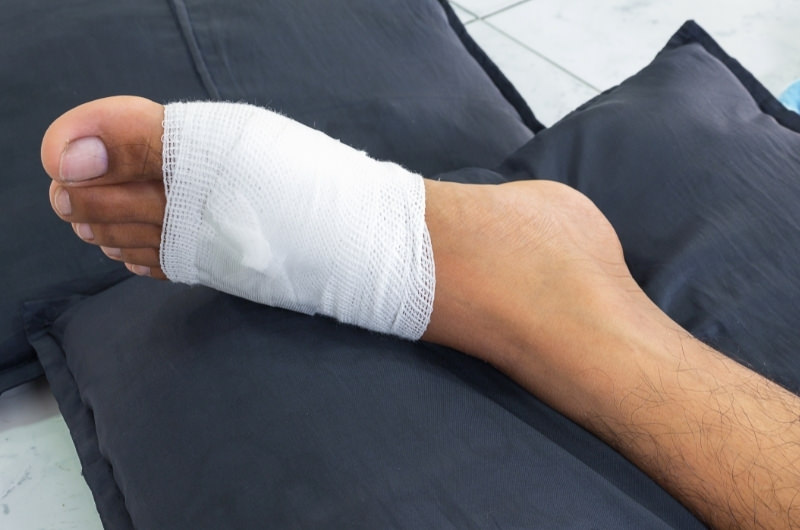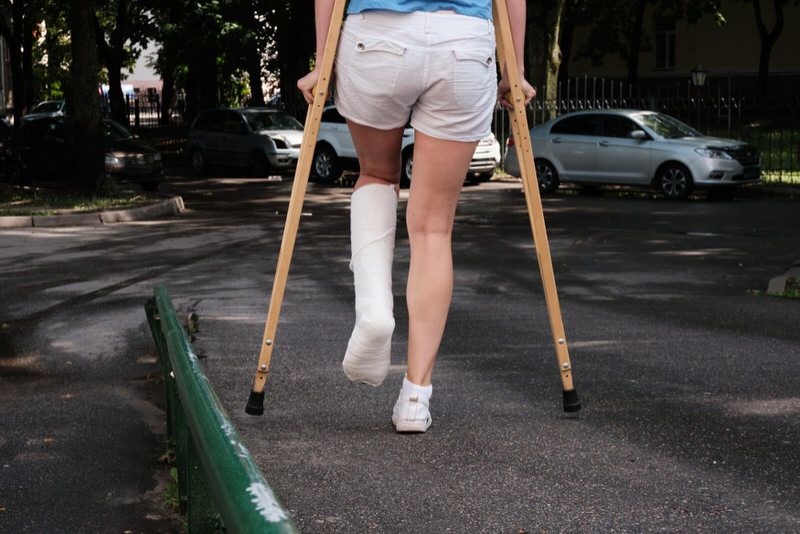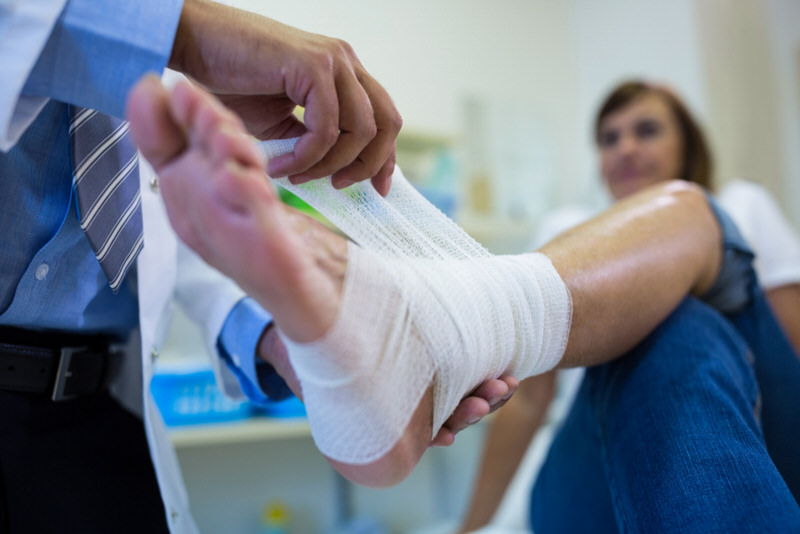Getting stitches on the bottom of your foot is a sure sign of deep laceration. The after-care of getting stitches is essential for proper and timely healing. Your wound should be able to heal in 2-3 weeks. Taking care of stitches includes keeping them dry, clean, bandaged, properly resting, and taking medications on time. Avoid scratching, walking, and doing any stressful activity that might reopen your wounds. Visit your doctor if you see any signs of infection.
So, you’ve recently suffered an injury on the bottom of your foot where stitches were necessary to get the cut to heal correctly.
Depending on the kind of cut, be it shallow or deep, you get stitches. But the real challenge comes afterward when you have to take care of stitches and follow all instructions for a long time to come.
After-care is essential, and you need to follow all the instructions your doctor provides you with to the point.
Taking care of stitches on the bottom of the foot can be tricky since you can’t walk unless it heals completely. Therefore assistance is crucial. Let’s look at how you should be taking care of the stitches at the bottom of your foot.
Foot laceration
Before diving into tips and ways to take care of the stitches at the bottom of your foot, let’s take a look into the cut you received, another name for which is a laceration.
If the cut is shallow and is in the body’s outer layer affecting only the skin, it might not require stitches. Instead, it can be treated with surgical tape closures or skin glue.
If the cut is deep and extends under the skin, it can affect the fatty tissue, muscle, tendon, nerve, even the bone. You should immediately be rushed to a hospital near you as it needs medical care at this point. Use a cloth to apply pressure to the wound.
If the wound is shallow, there won’t be a lot of blood, then the first thing you need to do is clean the wound with soap and water. Then apply an antibiotic ointment to reduce the chance of infection. Then put a sterile bandage on the area. After a few days, the dressing can be removed to let the wound heal.
If the cut is deep, stitches are given along with a tetanus injection as there might be a chance your wound is highly infected.
After-care for stitches on bottom of foot
1. Keeping stitches dry

Initially, you would be asked to keep your stitches dry. This means you can’t get your wound wet when showering. Keep the area completely dry for the next 24 to 48 hours. Don’t get the wound wet unless your doctor says so.
Dress your wound appropriately by covering it in plastic wraps when going for a shower.
It’s best not to shower and use a bucket for bathing for two days. Keep your feet on a small stool to avoid getting them wet.
2. Keeping stitches clean
It’s a given that your stitches and the surrounding area should be kept dry at all times. When your doctor has allowed you to wet the stitches, you can wash your wound area with warm water once or twice a day.
Make sure your hands are clean before you touch your wound, and try to clean it to avoid infecting it with germs.
Don’t soak your stitches directly in water or pour water on them but sponge it with a clean wet towel. Dry it immediately after cleaning your wound.
3. Bandage on stitches
If your doctor asks you to cover your wound with a waterproof dressing, then remember to change it regularly once a day.
You don’t want to use the same dressing for days as it will increase the chances of getting it infected.
4. Infections
You need to check your stitches every day to know if it’s healing or becoming worse.
Taking care of your wound by following your doctor’s instructions should keep it from getting infected. A closer look will prevent your stitches from getting severely infected.
There’s a need to worry and visit your doctor if you notice:
- Swelling
- Pus
- Redness
- Bleeding
- Extreme sensitivity
5. Don’t pick your stitches
As your wound starts to heal, it will become itchy. It doesn’t matter how itchy it might become; you should never scratch at your stitches as it can cause more harm than do better. For a moment’s relief, you might risk reopening your wound before it’s completely healed.
It can further lead to your wound becoming infected and worsening the whole situation. You should take some medication for the pain, but you shouldn’t pick at your stitches for the itchiness.
6. Resting and avoid walking

As the stitches are at the bottom of your foot, it makes sense to keep your foot from touching the ground unless it’s completely healed.
Don’t even think about walking on your stitched foot, as your vulnerable foot won’t be able to take any direct pressure.
You need to keep your foot away from any strain, so wholly avoid walking. Keep your foot elevated on a pillow to give it the maximum amount of comfort and rest. Doing this will also help improve blood circulation, prevent inflammation, and promote faster healing.
Use crutches when walking to keep your wounded foot from touching the ground.
7. Medication for pain
You’re bound to be in pain for a while after getting stitches, and taking pain medications will help you remain calm during the healing process.
Your doctor will also be recommending you some over-the-counter medicines for your pain. Take the medication as prescribed by your doctor.
8. Use an ice pack
You will also be needing to provide some relief to the wounded area by using an ice pack on the stitches.
Use it for 15 to 20 minutes at a time to numb the area. Before using an ice pack, carefully cover the wounded area with a cloth to avoid getting wet.
Leave your ice pack for 20 minutes at a time to get some relief from your pain. Doing this multiple times a day will help you out immensely.
If you do it all the time and over 20 minutes, it could prove harmful for your stitches.
9. Applying ointment
Some doctors also prescribe applying an ointment which works as an antibiotic and pain relief for your stitches. This ointment will help slightly numb the stitches, provide relief from itching or irritation.
The stitches at the bottom of your foot should take three months to heal properly. If you don’t see improvement in your stitches and notice any unusual changes in your wound, immediately visit your doctor.
FAQs
Can I walk after getting stitches?
When you’ve got stitches on the bottom of your foot, it’s apparent that you won’t be able to walk unless the stitches are gone, and the wound heals completely. The tentative time for the injury to heal at the bottom of your foot is 3 weeks.
After you’ve recovered, you should take it lightly by only walking. Avoid any other stressful active activities for a while.
How do you tell if stitches are healing properly?
One sure sign of healing is feeling the urge to itch on your wound. Other signs that can show recovery are that the wound’s edges will pull together. You might see some thickening there. You might also be able to spot some red bumps inside your shrinking wound.
Sharp shooting pain in the wound is another sign of healing. It means you’re getting sensations back in your nerves.
What should you not do with stitches?
1. Don’t try to scratch your wound under any circumstance, as this might reopen your stitches.
2. Don’t do water activities or sports unless and until your wound is completely healed and your doctor says so.
3. You obviously can’t walk on your foot when you’ve got stitches at the bottom of it.
Is Vaseline good for stitches?
You can use petroleum jelly to apply it to your stitches and cover it with a non-stick bandage. Please don’t use an ointment with hydrogen peroxide or alcohol in it, as this can slow down your healing process.
How do you sleep with stitches?
When you’ve got stitches on the bottom of your foot, sleeping could be tricky if you don’t know what to do.
While sleeping, you should keep your feet raised on a pillow of two based on how well the pillow can lift your leg. You should elevate your legs above the level of your heart, which helps in the blood circulation of your wound.
To summarize
A laceration (cut) at the bottom of your foot can be shallow or deep. You would obviously need stitches for a deep cut, which come with an extensive list of after-care.
Taking care of your stitches can be done by taking medications on time, bandaging your wound, keeping it dry and clean for a faster healing process.
The biggest challenge would still not be able to walk for a while. If you take care of your stitches properly and don’t see any other issues with your wound, you should heal under the speculated time frame.
Don’t hesitate to visit your doctor if you see your injury turning red, pus formation, bleeding, or any other sign that shouldn’t be there!


